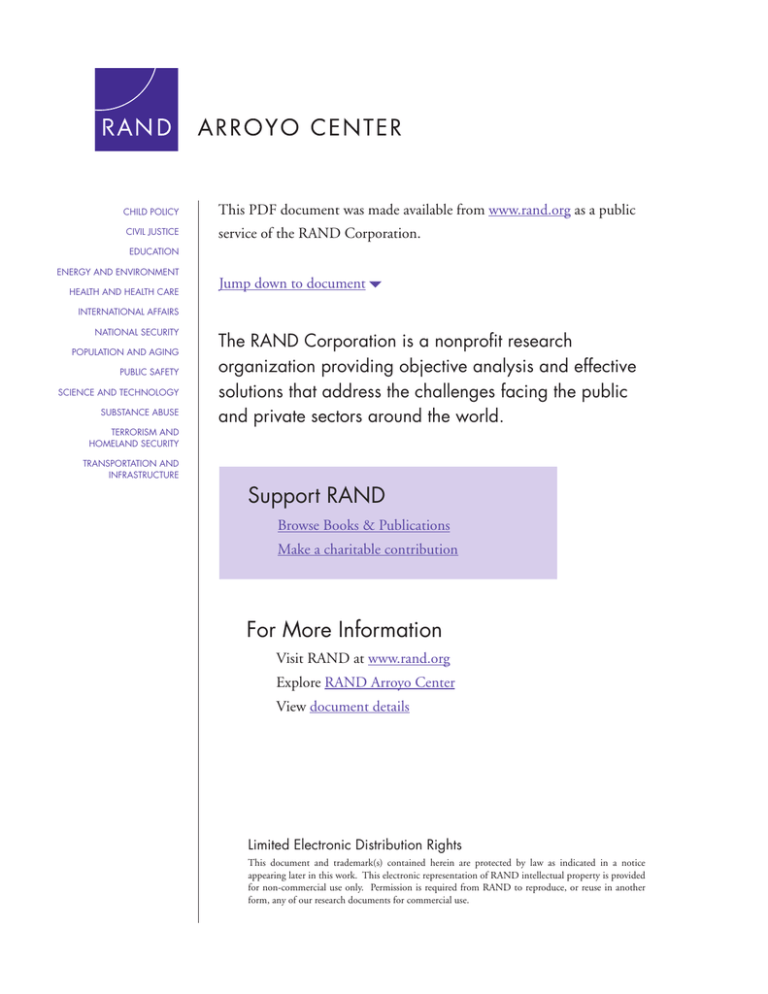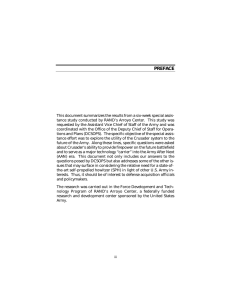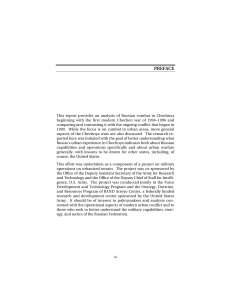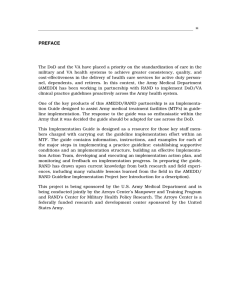6 om as a public service of the RAND Corporation.
advertisement

CHILD POLICY CIVIL JUSTICE This PDF document was made available from www.rand.org as a public service of the RAND Corporation. EDUCATION ENERGY AND ENVIRONMENT HEALTH AND HEALTH CARE Jump down to document6 INTERNATIONAL AFFAIRS NATIONAL SECURITY POPULATION AND AGING PUBLIC SAFETY SCIENCE AND TECHNOLOGY SUBSTANCE ABUSE TERRORISM AND HOMELAND SECURITY The RAND Corporation is a nonprofit research organization providing objective analysis and effective solutions that address the challenges facing the public and private sectors around the world. TRANSPORTATION AND INFRASTRUCTURE Support RAND Browse Books & Publications Make a charitable contribution For More Information Visit RAND at www.rand.org Explore RAND Arroyo Center View document details Limited Electronic Distribution Rights This document and trademark(s) contained herein are protected by law as indicated in a notice appearing later in this work. This electronic representation of RAND intellectual property is provided for non-commercial use only. Permission is required from RAND to reproduce, or reuse in another form, any of our research documents for commercial use. This product is part of the RAND Corporation research brief series. RAND research briefs present policy-oriented summaries of individual published, peer-reviewed documents or of a body of published work. Broadening the Army’s Bandwidth RAND RESEARCH AREAS CHILDREN AND ADOLESCENTS CIVIL JUSTICE EDUCATION ENERGY AND ENVIRONMENT HEALTH AND HEALTH CARE INTERNATIONAL AFFAIRS U.S. NATIONAL SECURITY POPULATION AND AGING PUBLIC SAFETY SCIENCE AND TECHNOLOGY SUBSTANCE ABUSE TERRORISM AND HOMELAND SECURITY TRANSPORTATION AND INFRASTRUCTURE This product is part of the RAND Corporation research brief series. RAND research briefs present policy-oriented summaries of individual published, peer-reviewed documents or of a body of published work. Corporate Headquarters 1700 Main Street P.O. Box 2138 Santa Monica, California 90407-2138 TEL 310.393.0411 FAX 310.393.4818 © RAND 2004 www.rand.org T he Army is transforming itself from a heavy Cold War force to a much more agile one, which it has dubbed the future force. A crucial part of that transformation requires the Army to shift its communications from being segmented to being networked. The difference is that in the former it is easy to communicate up and down vertical communication stovepipes but not across them. In the latter, any node in the network can communicate with any other node. Networked communications require considerable bandwidth, which facilitates the capacity to send and receive information. The Army is concerned about whether it has enough bandwidth available and asked RAND Arroyo Center to determine the nature and extent of potential bandwidth problems for the future force. The specific concern is whether enough capacity exists to meet the operational requirements spelled out for the future force. The results of that research appear in Future Army Bandwidth Needs and Capabilities. Bandwidth: Demand and Supply Demand for bandwidth has been increasing exponentially. For example, Operation Noble Anvil, the U.S. operation in Kosovo, is estimated to have used from 2 to 2.5 times the bandwidth used in Operation Desert Storm, a much larger operation. Operation Enduring Freedom in Afghanistan marked the largest military use of bandwidth to that time and exceeded that used in the Gulf War by a factor of 7. A recent estimate indicates that Operation Iraqi Freedom required roughly 10 times the bandwidth demanded by the Gulf War. Demand will continue to grow, with the result that it will far outstrip supply. The figure shows an initial assessment of the requirements for bandwidth, based on preliminary requirement documents, compared with estimated supply. The figure shows peak bandwidth requirements for a brigadesized unit compared with what is anticipated to be accessible based primarily on spectrum available Key findings: • Bandwidth is critical to the Army’s concept for its future forces • The demand for bandwidth will exceed supply • Bandwidth must be managed and allocated as an important combat resource • No single approach will solve the Army’s bandwidth problem, so it must pursue several approaches today (in CONUS) or expected to be available in the near term. In rough terms, demand exceeds supply by hundreds of megabits. The bulk of the demand will be made up of sensor data needs. Army Options and Actions In broad terms, the Army’s options to address the bandwidth problem are few: (1) get the most out of the hardware and software, i.e., use improved radios and antennas and make better use of allocated spectrum; (2) get the most out of the network’s architectural options, e.g., employ hierarchical schemes using vertical nodes such as unmanned aerial vehicles; and (3) look for ways to hold capacity demands to only what is needed. In order of priority, Arroyo researchers recommend that the Army take the following actions. Reassess Information Demands and Needs As a first order of business, the Army must understand what drives its information demands. We have only scant data on the details of actual demands as well as relatively little analysis of the necessity and the value of proposed information flows at each of the various echelons. Furthermore, Estimates Suggest That Future Demand Will Exceed Supply 1,000 Mbps Situational awareness, data, voice, other Sensor data 0 Required Available because demand is not the same as need, the Army must reassess the necessity of these information requests. More experimentation is needed to determine how various information demands contribute to mission success. Change Application Structure Applications determine the volume and timing of much of the information flow. Adjusting applications demands, for example by compressing them, can radically decrease bandwidth requirements. Minimizing the need to send raw sensor data will also be beneficial, especially if data can be fused locally. However, explicit performance assessments must be conducted to maintain quality with respect to data fusion and compression. Manage Operational Demands to Meet Needs The priority afforded a given user of a network will vary depending on the situation. During a battle, operational traffic should have priority, but logistics traffic may be more important during a repair, refuel, and rearm phase. Changing information needs mean that the network must be managed actively to ensure that important communications get priority and to smooth flow through the network. Increase Efficiency of Network Routing Army communications are increasingly network based and must be addressed from a network perspective. The Communication and Electronics Research, Development and Engineering Center (CERDEC), the Defense Advanced Research Projects Agency (DARPA), and commercial industry are attempting to increase capacity through more efficient routing through networks. These techniques take advantage of knowledge of the network state to improve routing efficiency. Increase Capacities of Links CERDEC and DARPA are working to increase link capacities. Directional antennas can increase capacity substantially, although more development is needed to get the full benefits of this concept. Directional antennas are more efficient because they transmit and receive in a focused way. Developed to their full potential, directional antennas could reduce the inherent capacity limitations of large numbers of radios sharing a frequency channel. Today’s allocation of available frequencies limits capacity, especially for ground vehicles on the move. Commercial demands are competing for the spectrum available for use by the military. Limited access to the spectrum makes it difficult for Army units to train as they will fight, and, by some estimates, not enough spectrum is available to support a brigade-sized exercise. Spectrum reuse is key to achieving as much capacity as possible. Directional antennas facilitate reuse even with fixed frequency allocations. Fully dynamic spectrum management could aid even greater reuse of the spectrum by doing away with the need for static channel/frequency assignments. Dynamic spectrum management finds available frequencies that may not be used at a particular time. DARPA is developing technologies to enable dynamic access to radio frequency spectrum. This important technology concept needs to receive continued support. Overall Assessment and Recommendations Bandwidth is a limited resource that needs to be managed. New technologies will greatly increase capacity, but unchecked user demands will probably keep pace and exceed available capacities. No single technique will solve the problem. The challenge is to meet the right users’ needs at the right time. To achieve this, Arroyo researchers recommend that the Army do the following. First, bandwidth needs to be treated as an operational resource to be allocated by commanders and staffs much in the way that other resources such as close air support are allocated. Second, the Army should continue to pursue all technologies that could provide benefit, because no single technology will resolve the bandwidth problem. A single agency should synchronize technology development for efficiency and coordination. This includes not only communications systems but also systems-of-systems to reduce demands and create an overall information architecture. Third, the Army should develop and refine assessment tools; better assessment tools are needed to make complex tradeoffs. Last, the Army needs to make a partner of DoD to avoid unnecessary redirection and to take advantage of DoD-wide capabilities. This is especially important with respect to the DoD efforts to maintain and perhaps acquire new spectral allocations. This research brief describes work done for RAND Arroyo Center documented in Future Army Bandwidth Needs and Capabilities, by Leland Joe and Isaac Porche III, MG-156-A (available at http://www.rand.org/publications/MG/MG156/), 2004, 134 pp., $20.00, ISBN: 0-8330-3545-2. MG-156-A is also available from RAND Distribution Services (phone: 310.451.7002; toll free: 877.584.8642; or email: order@rand.org). The RAND Corporation is a nonprofit research organization providing objective analysis and effective solutions that address the challenges facing the public and private sectors around the world. RAND’s publications do not necessarily reflect the opinions of its research clients and sponsors. R® is a registered trademark. RAND Offices Santa Monica RB-9064-A (2004) • Washington • Pittsburgh • New York • Doha • Berlin • Cambridge • Leiden





